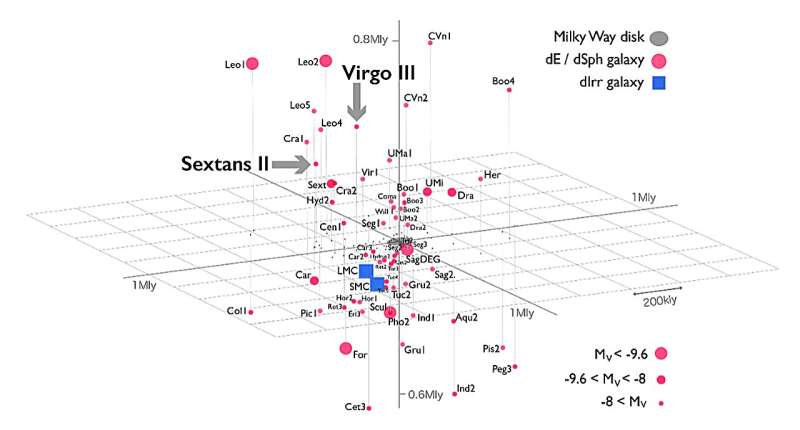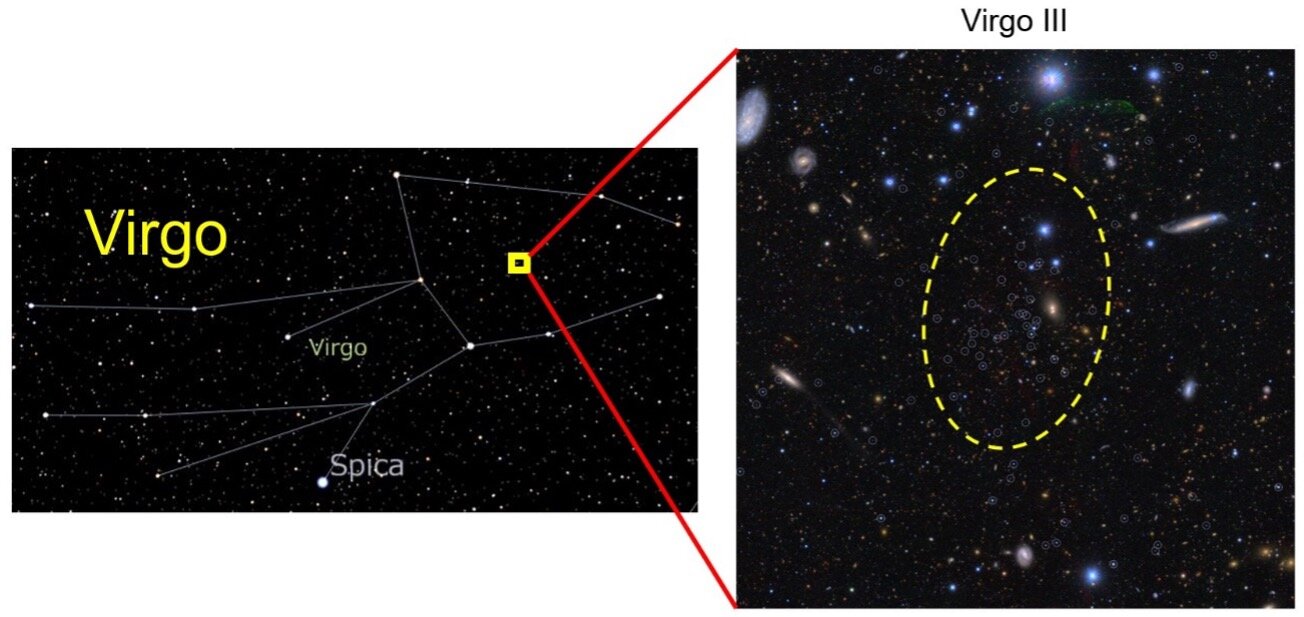The position of a newly found dwarf galaxy (Virgo III) in the constellation Virgo (left) and its members (right; the stars circled in white). The member stars are concentrated within the dotted line in the right panel. Credit: NAOJ/Tohoku University
For years, astronomers have worried about how to explain why the Milky Way has fewer satellite galaxies than the standard dark matter model predicts. This is called the “missing satellites problem”.
To bring this problem one step closer, an international team of researchers used data from the Subaru Strategic Program (SSP) of the Hyper Suprime-Cam (HSC). They have discovered two completely new satellite galaxies.
These results have been published in the Publications of the Astronomical Society of Japan on June 8, 2024 by a team of researchers from Japan, Taiwan and America.
We live in a galaxy called the Milky Way, with other, smaller galaxies orbiting it called satellite galaxies. Studying these satellite galaxies can help researchers unravel mysteries surrounding dark matter and better understand how galaxies evolve over time.

The area observed by the HSC-SSP (area surrounded by red lines). Previously known satellite galaxies are indicated by black squares, and newly discovered satellite galaxies are indicated by white triangles and stars. Credit: NAOJ/Tohoku University
“How many satellite galaxies does the Milky Way have? This has been an important question for astronomers for decades,” says Masahi Chiba, a professor at Tohoku University.
The research team recognized the possibility that there are likely many undiscovered, small satellite galaxies (dwarf galaxies) that are far away and difficult to detect. The powerful power of the Subaru telescope, which sits atop an isolated mountain above the clouds in Hawaii, is well suited to finding these galaxies. In fact, this research team previously found three new dwarf galaxies using the Subaru Telescope.
Now the team has discovered two more dwarf galaxies (Virgo III and Sextans II). With this discovery, a total of nine satellite galaxies have been found by different research teams. This is still far fewer than the 220 satellite galaxies predicted by the standard theory of dark matter.

Satellite galaxies around the Milky Way. The plane of the galactic disk lies on the horizontal plane. The blue squares are the Large and Small Magellanic Clouds, and the red circles are other satellite galaxies. The fainter their absolute visual magnitude, the smaller the spot size. Credit: NAOJ/Tohoku University
However, the footprint of the HSC-SSP does not cover the entire Milky Way. If the distribution of these nine satellite galaxies across the entire Milky Way is similar to what was found in the footprint captured by the HSC-SSP, the research team calculates that there may actually be closer to 500 satellite galaxies. Now we are faced with a ‘too many satellites problem’, rather than a ‘missing satellites problem’.
To better characterize the true number of satellite galaxies, more high-resolution imaging and analysis are required. “The next step is to use a more powerful telescope that provides a wider view of the sky,” Chiba explains. “Next year the Vera C. Rubin Observatory in Chile will be used to achieve that goal. I hope many new satellite galaxies will be discovered.”
More information:
Daisuke Homma et al, Final results of the search for new Milky Way satellites in the Hyper Suprime-Cam Subaru Strategic Program study: discovery of two more candidates, Publications of the Astronomical Society of Japan (2024). DOI: 10.1093/pasj/psae044
Provided by Tohoku University
Quote: Astronomers discover two new candidates for Milky Way satellite galaxies (2024, June 28), retrieved June 29, 2024 from https://phys.org/news/2024-06-astronomers-milky-satellite-galaxy-candidates.html
This document is protected by copyright. Except for fair dealing for the purpose of private study or research, no part may be reproduced without written permission. The contents are provided for information purposes only.
